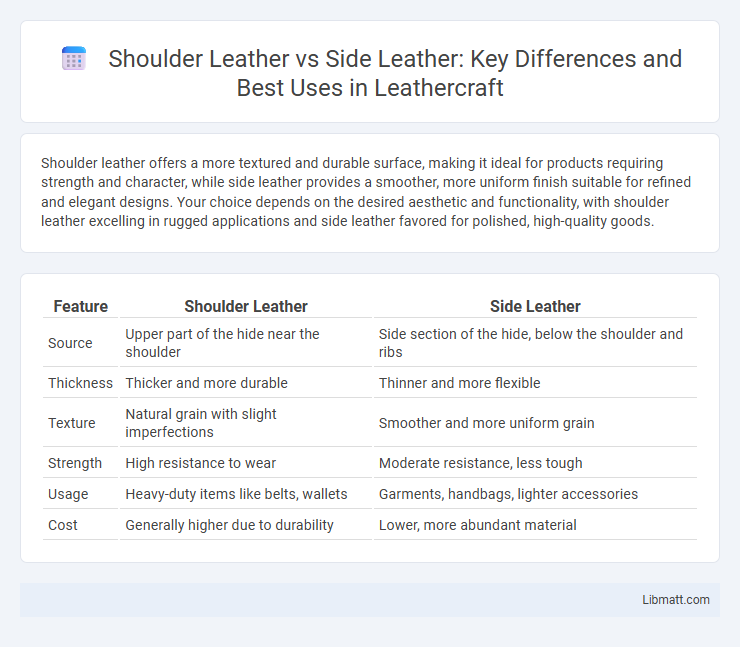Shoulder leather offers a more textured and durable surface, making it ideal for products requiring strength and character, while side leather provides a smoother, more uniform finish suitable for refined and elegant designs. Your choice depends on the desired aesthetic and functionality, with shoulder leather excelling in rugged applications and side leather favored for polished, high-quality goods.
Table of Comparison
| Feature | Shoulder Leather | Side Leather |
|---|---|---|
| Source | Upper part of the hide near the shoulder | Side section of the hide, below the shoulder and ribs |
| Thickness | Thicker and more durable | Thinner and more flexible |
| Texture | Natural grain with slight imperfections | Smoother and more uniform grain |
| Strength | High resistance to wear | Moderate resistance, less tough |
| Usage | Heavy-duty items like belts, wallets | Garments, handbags, lighter accessories |
| Cost | Generally higher due to durability | Lower, more abundant material |
Introduction to Shoulder Leather and Side Leather
Shoulder leather originates from the upper part of the cowhide near the shoulder area, known for its durability and natural grain, often used in high-quality leather goods requiring strength and texture. Side leather, taken from the larger middle section of the hide, offers a more consistent grain and smooth surface, making it ideal for refined leather products like garments and upholstery. Both types provide unique characteristics that influence the final product's appearance, durability, and flexibility.
Defining Shoulder Leather
Shoulder leather is derived from the upper part of the cowhide, known for its toughness and natural markings, making it ideal for durable leather goods like jackets and bags. This leather features a coarser grain compared to side leather, providing a unique texture favored in rugged applications. Shoulder leather offers a balance of strength and flexibility that differentiates it from the smoother, more uniform side leather.
Defining Side Leather
Side leather refers to the full side cut from the hide, extending from the shoulder to the middle of the cow's body, prized for its balance of durability and flexibility. Shoulder leather, by contrast, comes from the front section and usually contains natural imperfections and a tighter grain, offering more texture but less uniformity. Understanding the difference helps you select leather that matches your project's needs for strength, appearance, and wear resistance.
Origin and Sourcing of Each Leather Type
Shoulder leather is sourced from the upper part of a cowhide, prized for its durability and natural grain, making it ideal for heavy-duty goods. Side leather comes from the middle section of the hide, offering a larger, more uniform surface favored for large leather goods due to its balance of strength and flexibility. Both types originate from cowhide but differ significantly in texture and strength based on their specific location on the animal.
Texture and Grain Differences
Shoulder leather features a coarser texture with pronounced grain, offering durability suited for rugged use, while side leather is smoother with a more uniform grain pattern, making it ideal for finer, detailed craftsmanship. The natural imperfections and tighter grain of shoulder leather contribute to its strength, whereas side leather's even surface provides a polished appearance. When choosing leather for your project, consider these texture and grain differences to match the aesthetic and functional needs effectively.
Durability Comparison: Shoulder vs Side Leather
Shoulder leather offers exceptional durability due to its dense fiber structure and natural strength, making it ideal for heavy-use applications like belts and bags. Side leather, while still durable, tends to be thinner and more pliable, providing flexibility but less resistance to wear compared to shoulder leather. Your choice depends on whether you prioritize long-lasting toughness or a softer, more flexible material for your leather goods.
Typical Uses and Applications
Shoulder leather, known for its durability and slightly textured surface, is typically used for making bags, wallets, and upholstery where both strength and flexibility are required. Side leather, being more consistent in thickness and smoother, is ideal for footwear, garments, and high-end leather goods that demand a refined finish. Your choice depends on whether you prioritize toughness and character (shoulder leather) or uniform appearance and cut precision (side leather).
Cost and Value Analysis
Shoulder leather typically costs less than side leather due to its thicker grain and more imperfections, which reduce its overall value in premium applications. Side leather is more uniform, lighter, and smoother, increasing its market value and suitability for high-end upholstery and fashion items. Evaluating cost and value shows side leather offers better durability and aesthetic appeal, justifying its higher price point in quality-driven projects.
Pros and Cons of Shoulder Leather
Shoulder leather offers increased durability and strength due to its denser grain structure, making it ideal for products that require toughness and long-lasting wear. Your leather goods made from shoulder leather tend to develop a unique patina over time but may be less flexible and heavier compared to side leather. The trade-off involves balancing its rugged toughness against limited suppleness, which can affect comfort and ease of use in certain applications.
Pros and Cons of Side Leather
Side leather offers a balance of durability and flexibility, making it ideal for products requiring a smoother surface and medium strength. It tends to be less expensive than shoulder leather but can be more prone to scratches and less resistant to stretching. The natural grain is less pronounced, which may not appeal to those seeking a highly textured, rugged look.
Shoulder leather vs side leather Infographic

 libmatt.com
libmatt.com